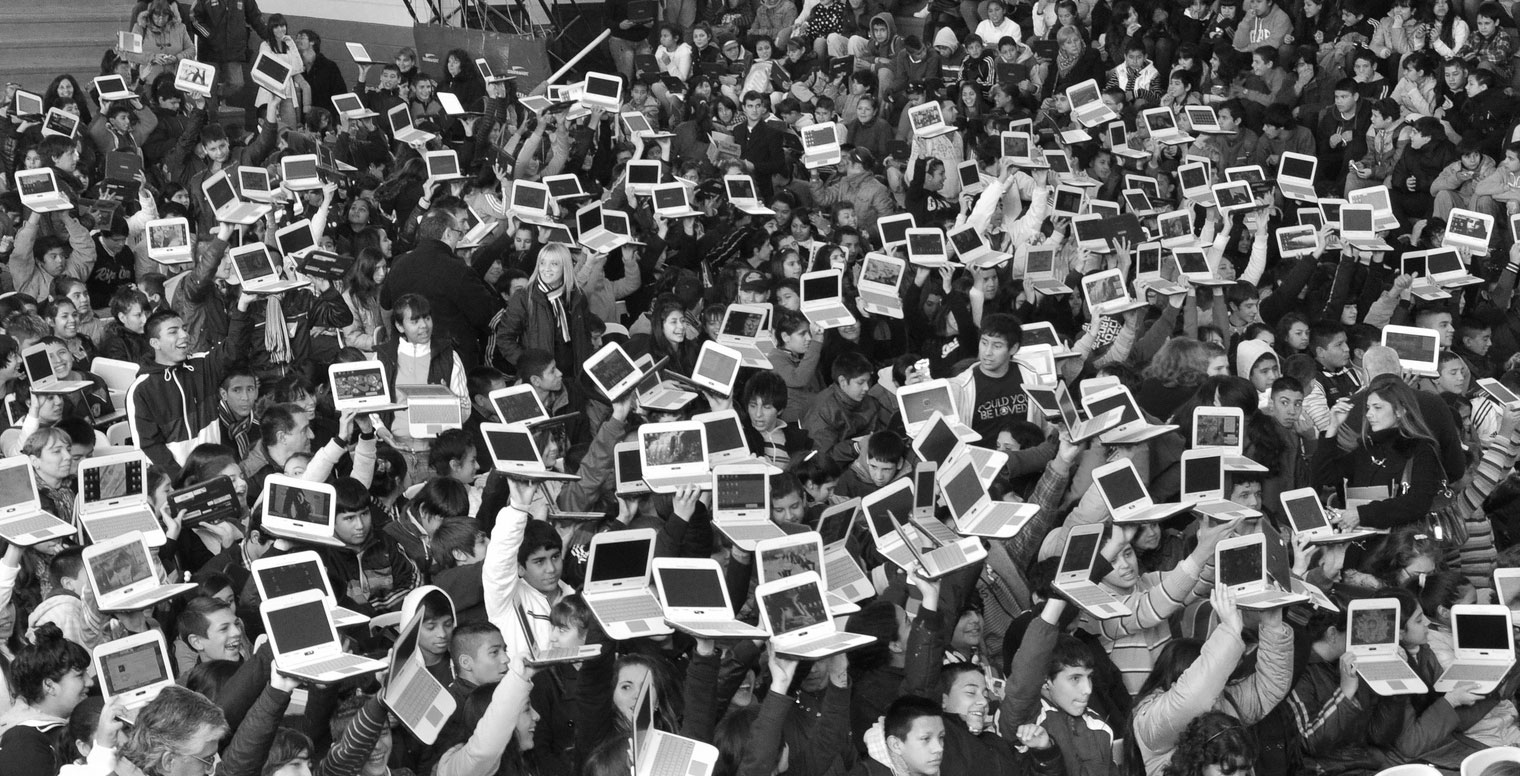
Students with netbooks from the program Conectar Igualdad. Argentina, 2012. Source: Flickr
An overview of the state of implementation and the use of the internet in Latin America, an area that makes up 10% of the world’s internet users. This article presents three case studies based on political, technical or civic innovation that offer a good overview of the diverse ways of thinking about and using the internet: FLOK Society in Ecuador, Rhizomatica in Mexico, and the case of Cuba: the other internet.
A Social Media Paradise
Latin Americans make up 10% of the world’s internet users. What do we use the internet for? Everything indicates that we love communicating, nobody spends as many hours on social media as we do: an average of five hours a month, which is five hours more than the world average. We also make up 20% of Facebook’s user base and almost 40% in the case of WhatsApp. Our presence on other social networks such as Twitter, LinkedIn and YouTube has also grown exponentially over the last few years, primarily due to three factors:
- The ongoing improvement of internet infrastructure,
- the wide penetration of mobile devices in Latin America,
- and an enormous population of young people hungry for social content.
Latin America is a social media paradise —Brazil has been called the world’s social media capital —, and the region is so dynamic that companies and businesses are starting to look at us with ambitious seriousness.
Will we keep growing?
The internet is growing rapidly in Latin America, perhaps faster than ever before. According to the UN Economic Commission for Latin America and the Caribbean (ECLAC), the region’s internet penetration has doubled in recent years, rising from 20.7% in 2006 to 46.7% in 2013.
The bad news is that only a third of that rate is broadband: internet speeds in Latin America are up to sixteen times lower than in developed countries and, worse still, access can be up to twenty times more expensive.
But there are strong indications that internet coverage and speed in Latin America will continue to increase:
- USAN (the Union of South American Nations) is planning to build an infrastructure it calls the “digital ring”: a 10,000 kilometre optic fibre network that will significantly improve internet access and speeds in the southern region of America. USAN expects it to be ready in 2020.
- In Brazil, the region’s largest economy, over 100 million people – more than half of the country’s population – are connected to the net. This puts it fifth on the world ranking, after countries like China and the USA. The growth of Brazil is due to an interesting combination of governmental policies and, above all, grassroots citizen efforts. Some of the advanced policies regarding internet access and use in Brazil include its exemplary Civil Rights Framework for the Internet, which protects civil rights online, and the hundreds of independent internet service providers that function as “small producers” spread all over the country. This is an example that deserves to be reproduced throughout the region.
- In North America, Mexico, and Costa Rica progress has been made through regulatory frameworks that seek to promote competition and increase internet coverage. Mexico, in particular, faces the challenge of weakening the monopoly of Telmex, a private corporation owned by Carlos Slim that increases the price of accessing the net while at the same time providing low quality service due to the lack of competition. All of this is quickly changing to the benefit of over 50 million people.
However, it should be noted that Mexico’s telecommunications reform includes aspects that threaten internet neutrality –a basic principle that ensures a competitive balance among service providers and their users. These are serious concerns for the digital rights of Mexicans.
Three different ways of making internet
Below I describe three projects based on political, technical, or grassroots innovation that offer a good overview of the diverse forms in which we use and think about the internet in Latin America.
Ecuador: FLOK Society
Free/Libre Open Knowledge (FLOK) Society is an Ecuador-based project for the collaborative creation of public policies. It aims to develop a free knowledge society based on the connectivity of the internet and its networks.
It is profoundly influenced by two philosophies:
- The philosophy of free software , according to which all knowledge must be free, shared, and created as part of a community and which is, in turn, inspired by the so-called “hacker ethic” that developed at the dawn of computing (in the early seventies) and defends the right to access all knowledge.
- It also draws on the idea of the Pachamama, encompassing “principles of reciprocity (randi-randi) and the organisation of community work (maki-maki)”, which generate a cultural commons in the Andes.
Guided by these principles, FLOK was founded in 2013, bringing together dozens of experts grouped around issues of strategic importance for Ecuador, as well as politicians, lawyers, academics, artists, and hackers, all seated at the same table. These meetings led to the organisation of the BuenConocer Summit , which gave rise to the collaborative book “FLOK Society: Buen Conocer”.
FLOK is a political response that is the opposite of “cognitive capitalism”:
“The Knowledge Revolution proposes innovation, science and technology as the foundations for change in the production structure, which is conceived as a distinct form of production and consumption.”
FLOK is still underway and, like free software, it generates a “code” of public policies ready to be learnt and improved anywhere in the world.
Mexico: Rhizomatica
The mission of Rhizomatica is to increase access to mobile telecommunications by the more than two billion people who cannot afford to pay coverage, and the 700 million who have none at all. How do they do it? Using free software and hardware whenever possible for data transmission and reception, studying the relevant regulatory aspects, and training communities to preserve their communication autonomy.
The project began in Oaxaca, Mexico. Its first telecommunications station was set up in Talea, a Zapotec town with a population of 3,000 with no access to telephone services let alone the internet. As the coordinator of the project explains: : “In Talea, the town owns the equipment. There was an assembly, the townspeople said they wanted the internet, they purchased the equipment with the community’s money, and the infrastructure belongs to everybody.”
There are some 50,000 similar communities in Mexico, and Rhizomatica wants each of them to own their infrastructure. To date, the Rhizomatica team made up of hackers and engineers has installed around twenty communication networks in Oaxacan communities.
And, as they themselves explain, in 2015 they benefited from a section of the Mexican telecommunications reform that assigns certain bands for social use, particularly in zones which lack basic telecommunications infrastructure. This means that Rhizomatica operations are totally legal in Mexico.
We hope that they will continue to grow and offer access to mobile communications in general, and the internet in particular, to communities that were taken off the internet map by corporate business models and government negligence.
Cuba: The other internet
The general lack of internet access in Cuba has given rise to “the other internet”, a very modest network that does not use cables, modems, or any kind of infrastructure to connect devices and people: it uses hard drives and, of course, people who carry them from one place to another. It is known as the “Paquete semanal” (The Weekly Package).
Apparently, only 5% of the population has regular access to the Internet, and only 1% in the case of broadband. WiFi is only available in public areas, and the hourly rate is equivalent to 20% of the average weekly wage.
Under these conditions, internet access seems to have remained frozen in the nineties, and it is inconceivable to watch YouTube videos on a daily basis, to leisurely browse any newspaper in the world, or to set up a technology startup, as in other parts of the world.
But this situation is changing with the gradual lifting of the US embargo in 2015, and the Cuban government hopes that 50% of the population will have internet access at home by 2020.
What does El Paquete Semanal include? Almost everything. Television series, soap operas, music, films, video clips, a compilation of the leading magazines around the world, software, mobile phone applications, and so on. It even includes ads for local businesses.
Where does the material come from? Somebody has to download it first. The absence of pornographic and political material suggests that the government itself is involved in its production, but we don’t have any other information. Meanwhile, it is a lucrative business that will soon be obsolete if the Cuban government fulfils its promise of connectivity.
What next?
Latin America is a region of cultural, political, and technological extremes. It is logical that there should be so much diversity: some people simply want to watch the latest episode of their favourite series, while others want to build companies using Bitcoin to develop the economies of the future, all via the Internet.
What’s next for Latin America and the internet? Judging by current data, the next five years will bring radical changes to infrastructure and local regulations, which will mean tremendous dynamism for citizens. These changes will provide huge benefits in all senses, particularly in educational and economic terms, but they are also a latent concern in relation to digital rights.
Beyond bytes, machines, and source code, the internet is above all about connecting people, at the local and global levels, through knowledge and information. To “make internet” is to “constantly learn and create from the net, on the net, and for the net”. So given the complexity of the new networks and connections that will strengthen and expand the internet in Latin America, all we have to do now is participate and get ready to be surprised.




Leave a comment